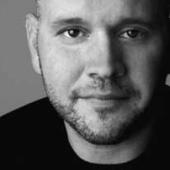In September 2007, I received a call from an employee of Children’s Hospitals and Clinics of Minnesota because he remembered me from Theater Latte Da's production of
Gypsy at what used to be the Loring Playhouse. It was a multi-character part that allowed me to play several different roles, as well as play the saxophone. He told me that he had kept his program, and I was flattered (though I later learned that this was not due to my performance but rather that he always kept his program). He remembered that in my bio I mentioned my job at Interact Center for the Visual and Performing Arts, a program for adults with disabilities.
It turned out that for 20-some years before its outside funding was pulled, Children’s Hospitals had its own closed circuit television show. They were looking to re-launch a new, live interactive T.V. show to which patients and families could call in from their bedside phone. The Family Services department felt it was important to continue offering something kids actually looked forward to doing while at the hospital—even though, at the time they called me, they had no equipment, no one to run the equipment if they got it, no set, nothing. Except a budget—and me, if I said yes.
I said yes.
I wasn’t sure what I was doing. I hadn’t worked in television much. My qualifications were an improvisation background, my work with populations with special needs, and maybe that I am a father. But working at Children’s Hospitals, whatever the result, would allow me to pursue my own curiosity about how theater/performance can not only provide escape for a performer or an audience but actually help heal, or, at least, help make "feel better."
Laughter is contagious as a virus, but healthier
My curiosity was first peaked during my three year (’97-‘00) stint at The Brave New Workshop. At the time, I was performing on the main stage in
Viagra! The Second Coming!. A sketch, set at a St. Paul Saints game, was a hit every night. The cast sat facing the audience; hilarity ensued. On one particularly raucous evening, the audience laughed so hard that they seemed, from my point of view, to be simultaneously convulsing: rocking back and forth, clapping, doubling over, butts off the seats.
“Wow. That must feel so GOOD. These people have lost control," I remember thinking to myself.
Of course, these days,
there is plenty of research on the brain that proves that laughter
is good for you and a natural immunity system builder, among other things. I wanted to be a part of what makes that happen, somehow, and to learn more about the impact that we, as artists, have on our audience.
Quieting the voices
I learned plenty when I started working at Interact in 2000. Everyday, I worked with performers whose disabilities covered the spectrum, from a 20-year old with Down Syndrome to a 93-year stroke survivor. I have worked with actors with traumatic brain injuries who still memorize their lines through the same repetitious grind that all actors do. Even when one of these actors would occasionally forget a line, the improvisational work that we do at Interact prepared them to make something up and go on. Just like all actors would have to do.
Some of the actors at Interact are schizophrenic, or have other serious mental illnesses. One talented actress I know often sits by herself, speaking quietly to her voices. However, in 10 years in working with her, I have never seen her miss a cue or go up on a line. When I asked her how she is able to stay so focused onstage, she simply told me “When I’m onstage, they leave me alone.” As if the voices knew better than to talk while she was working. Or maybe it was that, through performance, she somehow found a place in her brain that allowed her to be 100% in the moment.
Kids, not patients
Learning about arts and healing continued when I accepted the position of Artistic Director of Star Studios at Children’s Hospitals. Since launching the show in January, 2008, I have met hundreds of kids and families as the character, "Dude." Dude is Everykid—but essentially he's me in a long wig, skull cap, and DC wear (a popular brand in the skater boy population).
The show, which airs live twice a week, is an interactive, closed-circuit, game show/variety hour for kids and families. Kids from anywhere on the Children's Hospital campuses in Minneapolis and St. Paul can call in from their rooms, answer questions, play games, and even—if they are well enough—come to our live broadcast. There have been patients who, with the encouragement of their physical therapists, make getting to the broadcast a goal of treatment.
It is truly one of the greatest, albeit emotionally taxing, jobs I have ever had or will ever have. For example, I will never forget a young girl, who struggled with respiratory issues and was in the intensive care unit, post surgery. Typically, I do not visit kids in this area; partially because none of the patients are well enough to watch the show but also because it really doesn’t seem like a place for a grown man in a wig. But she had made a special request that I stop in and see her that day, so we shared a few laughs. She had a hand-held, fart-machine noisemaker and pushed the buttons and pointed at me as if to lay blame. She was excited to see the show that day.
As I was leaving her room, her father stopped me. He was a David Crosby-looking guy—friendly, long hair, balding, the mustache—and he teared up as he told me that his daughter had a tough time pulling through after surgery. He told me that, at one point, he whispered to her “Dude would want you to fight.”
Honestly, this father believed that part of his daughter’s recovery was due to her dedication to the show and the unique bond she had with all of us working on it.
Other families actually schedule therapy and chemo around the time of the show, just so they don’t miss it. One parent explained to me, on the day that their child was being discharged from the hospital, “You give kids a chance to escape from being patients, so they can just be kids.”
So, I've been on the front lines of the rapidly growing clinical acceptance of the arts in healing, and I have to say that it's one of the most fulfilling and luckiest jobs I've ever had.




